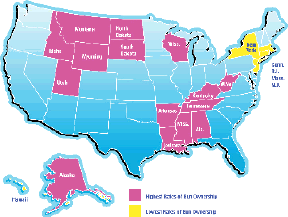 |
The Journal of Trauma, Vol. 62, Issue 4, April 2007
Abstract available at http://www.jtrauma.com/pt/re/jtrauma/abstract.00005373-200704000-00031.htm.
For some people, the conclusion reached by this study from the Harvard School of Public Health will produce a loud “duh!” If a place has more guns, it will have more suicides.
But in a country where suicide is the third leading cause of death among people under 24, and where the prevalence of guns is among the hottest of hot-button issues, it’s important to scientifically sort out the relationship between the two. Four Harvard researchers did that by examining the connection between each state’s suicide rate and its rate of household gun ownership.
The researchers found that states with the highest rates of gun ownership also had the highest rates of suicide, and that those with the lowest gun ownership rates had the lowest suicide rates.
The results are especially important for those working with youth who are depressed or at risk of suicide. The link between guns in the home and suicide was strongest among 5- to 19-year-olds, who commit about 1,800 suicides a year.
The study was sponsored by the Joyce Foundation, which supports increased gun regulation. Before avid gun owners dismiss it as a liberal attack on gun ownership, however, let’s look at its recommendations.
The study helps to answer the question about whether restricting access to guns would reduce suicides or simply divert suicidal people to other methods. Just over half of the 31,000 annual suicides in the United States are by firearms, and 90 percent of suicide attempts by firearms are fatal, according to the Harvard study.
The researchers used suicide data from the Centers for Disease Control and Prevention (CDC) from 2000 through 2002, and gun ownership data from the 2001 Behavioral Risk Factor Surveillance System, a CDC-sponsored telephone survey that draws more than 200,000 adult respondents across every state.
Among the conclusions: The 15 states with the highest rates of gun ownership had twice as many suicides as the six states with the lowest gun ownership rates. “Overall, people in high-gun states were 3.8 times more likely to kill themselves with firearms,” the study says. The populations of the two groups of states totaled 116 million and 119 million, respectively.
What’s more, said the study, the impact of gun ownership “was highest for women and for our youngest age group,” ages 5 to 19. There were 1,071 suicides in that age group in the 15 “high-gun states,” compared with 460 in the six “low-gun” states.
After controlling for differences in serious mental illness, drug and alcohol abuse, poverty and unemployment, the study found that the differences in suicide totals were due specifically to the higher number of
gun-related suicides in high-gun states.
Because the vast majority of suicides by firearm involve guns from the victim’s own home, “removing firearms may be especially effective in reducing the risk of suicide among adolescents and
other potentially impulsive members” of a household, study co-author Matthew Miller said in a statement announcing the study.
Barring that, those working with vulnerable youth whose families own guns might at least talk to the parents about making sure the weapons are, as the authors say, “very securely locked up and stored separately from secured ammunition.”
American Journal of Preventive Medicine, Vol. 32, Issue 4, Supp. 1, April 2007
Available at http://www.sciencedirect.com/science/journal/07493797.
Scientists belonging to a premier research group – staffed by the Centers for Disease Control and Prevention (CDC) and funded by the U.S. Department of Health and Human Services (HHS) – have ventured out on a controversial limb for the first time.
In this series of articles, the Task Force on Community Preventive Services recommended “against policies that facilitate the transfer of juveniles from juvenile to adult justice systems for the purpose of reducing violence.”
According to CDC epidemiologist Robert Hahn, a member of the task force, the study represents “the first time [we’ve] recommended against anything.”
Over the past decade, the group has reviewed more than 180 public health policies for inclusion in its main product, the CDC’s Guide to Community Preventive Services (www.cdc.gov/epo/communityguide.htm). The juvenile transfer study is part of a review of population-based interventions designed to reduce or prevent youth violence.
Forty states permit or require that juveniles who are charged as adults be detained before trial in adult jails, and many also require them to serve all or part of their entire sentence in adult prisons, according to a recent report from the Justice Policy Institute. Some researchers say as many as 200,000 youth are prosecuted as adults each year and that on any given day, 7,000 youth are held in adult jails. (See Report Roundup, page 25.)
After predictions in the early 1990s that a wave of teen “superpredators” would soon be terrorizing law-abiding citizens, state policy shifted away from rehabilitating juvenile offenders and toward tougher laws intended to punish them in the hopes of deterring youth violence. By 2000, all 50 states had passed legislation that made it relatively easy to prosecute juveniles in adult courts and incarcerate them in adult jails.
The task force review of some of the most rigorously conducted studies of those laws concludes that, “as a means of reducing juvenile violence, strengthened juvenile transfer policies are counterproductive.”
Not only do the laws fail to increase public safety, “they are in fact harmful” and “fail to reform kids in any way,” Hahn said.
Hahn said states count on the laws to work in two ways: “specific deterrence,” which is the belief that previously incarcerated youth will want to avoid re-experiencing the harshness of an adult facility; and “general deterrence,” which is the belief that youth who have never committed a crime are aware of transfer laws and fear the consequences of them.
“We reviewed the best evidence regarding both of these possibilities,” Hahn said. “The studies indicate that kids who are transferred to the adult criminal system are being more violent, being rearrested more often and at shorter intervals from their release dates than the kids who are retained in the juvenile system.” He said studies of general deterrence are, on the whole, inconclusive.
That’s not news to the juvenile justice research and advocacy fields, several experts said.
The trend toward tougher juvenile transfer laws “started to reverse about five years ago,” said Jeffrey Butts, a research fellow with Chapin Hall Center for Children at the University of Chicago. “If they are going out on a limb, we should just say, ‘Welcome to our limb.’ ”
Perhaps the task force’s bold “first” – and its ties to CDC, HHS and other federal agencies and national research institutions – might further the cause. Based in part on the group’s review of DUI testing policies, Congress required states in 2001 to drop their legal blood alcohol content thresholds to 0.08 percent or risk losing federal highway construction funds. All 50 states eventually legislated the lower blood alcohol content.
Jeffrey Fagan, professor of epidemiology at Columbia University’s Mailman School of Public Health, and the author of one of the juvenile transfer studies reviewed by the task force, has in mind a more grassroots use of the study’s findings. Considering the wide variations in the ways states have constructed their juvenile transfer laws, “this is not going to be a national campaign,” he said. “I think it’s really up to the advocates to run with this in the legislatures.”





























